Introduction:
A culvert is a structure designed to allow the passage of water, such as a stream or drainage, under a road, railway, or similar obstruction. It is an essential component of the transportation infrastructure, preventing flooding, maintaining water flow, and ensuring the integrity of the road or railway above. Culverts are typically constructed using durable concrete, steel, or plastic materials. They come in various shapes and sizes, depending on the specific requirements of the site and the volume of water that needs to be conveyed. Common culvert shapes include round, box, elliptical, and pipe arch.
The design and installation of culverts consider factors such as the anticipated water flow, the terrain, and the environmental considerations of the surrounding area. Proper design ensures that the trench can withstand the hydraulic forces exerted by the flowing water while maintaining structural integrity.
What is Culvert?
A culvert is a tunnel built under a road or train track to help water flow in both directions or to move electrical or other lines from one side to the other. It is surrounded by dirt or ground on all sides. Most of the time, pipe culverts, box culverts, and arch culverts are used under roads and railroads. The design of a trench is based on hydraulics, the height of the water level, the height of the road, and other factors. These are used to control the flow of water.
Culverts are typically made of durable materials such as concrete, steel, or plastic, and they come in various shapes and sizes depending on the site’s specific requirements. The most common shapes include round, rectangular, and elliptical culverts. The primary function of a culvert is to redirect water flow from one side of the obstruction to the other, ensuring the continuous movement of water and minimizing any negative impacts on transportation or the surrounding environment. By allowing water to pass underneath, culverts help to maintain the integrity of roads, railways, and other infrastructure.
Culverts are usually installed when constructing roads, bridges, or other transportation systems where a waterway intersects with the path. They are strategically placed to handle expected water flow rates and prevent blockages or overflows during heavy rainfall or floods. Culverts may also be used to channel streams or rivers beneath artificial structures.
Materials Used to Construct a Culvert:
Culverts are structures designed to allow the passage of water under roads, railways, or other obstructions. Depending on the expected water flow, environmental conditions, and budget, they can be made from various materials. Here are some common materials used to construct culverts:
(i) Concrete: Concrete culverts are widely used for durability and strength. Reinforced concrete pipes or precast concrete sections are commonly used to construct culverts. Concrete offers excellent corrosion resistance and can withstand heavy loads. (
ii) Steel: Steel culverts are often used when a high strength-to-weight ratio is required or must be prefabricated and transported to the construction site. Corrugated steel pipes are commonly used and are available in different shapes and sizes.
(iii)Aluminum: Aluminum culverts are lightweight and corrosion-resistant, making them suitable for culvert installations where weight or corrosive conditions exist. They are commonly used in coastal areas or locations with high salt content in the soil.
(iv) High-Density Polyethylene (HDPE): HDPE culverts are lightweight, flexible, and corrosion-resistant. They are typically supplied as large-diameter corrugated pipes or culvert sections. HDPE culverts are easy to install and require minimal maintenance.
(v) Polyvinyl Chloride (PVC): PVC culverts are lightweight, durable, and corrosion-resistant. They are commonly used for smaller culvert applications such as residential driveways or agricultural drainage systems. PVC pipes are available in various diameters and can be easily connected using fittings.
(vi) Masonry: In some cases, masonry materials such as bricks or stones may be used to construct culverts. These materials are often used for smaller culverts or when aesthetic considerations are important.
Design of Culvert:
The design of a culvert considers several factors to ensure its functionality, structural integrity, and efficiency in managing water flow. Here are the key aspects of culvert design:
(i) Hydrological Analysis: The design process begins with an assessment of the hydrological characteristics of the area, including the anticipated flow rates and volumes of water. Engineers analyze rainfall data, watershed characteristics, and topography to determine the design flow the culvert needs to handle.
(ii) Hydraulic Considerations: Based on the design flow, the hydraulic properties of the culvert are determined. It involves calculating the size and shape of the culvert to accommodate the expected water flow without causing excessive backwater or flooding. Hydraulic considerations also involve determining the entrance and exit conditions of the culvert to minimize energy losses and promote efficient flow.
(iii) Structural Design: The structural design of a culvert involves selecting the appropriate materials, shape, and dimensions to withstand the loads and forces it will experience. Factors such as the type of traffic above the culvert, soil conditions, and anticipated water pressures are considered. Common culvert shapes include circular, box, and pipe-arch, with circular being the most common due to its structural efficiency.
(iv) Inlet and Outlet Design: Proper design of the culvert’s inlet and outlet is crucial to maintain efficient flow and prevent erosion. The inlet should be designed to control the flow’s entry into the culvert, minimizing turbulence and potential blockages. Similarly, the outlet must be designed to avoid excessive scouring and erosion downstream.
(v) Site Conditions: The physical characteristics of the site, such as soil conditions, groundwater levels, and slope stability, play a significant role in culvert design. Engineers evaluate these factors to determine the appropriate foundation and bedding requirements, ensuring the culvert is properly supported and protected against settlement or movement.
(vi) Construction and Maintenance Considerations: The culvert design should consider construction feasibility and long-term maintenance. Factors such as ease of installation, accessibility for maintenance and inspection, and durability of materials are considered to ensure the culvert’s longevity and cost-effectiveness.
Types of Culverts:
1. Box Culvert:
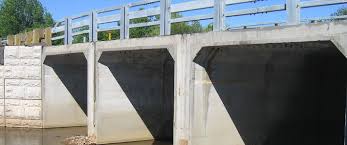
Fig1: Box Culvert
Courtesy: shawprecastsolutions.ca
A box culvert is a rectangular or square-shaped structure that conveys water or other fluids, typically under roads, railways, or canals. It is a type of culvert that provides a passage for water flow, allowing it to pass underneath an obstruction. Box culverts are commonly constructed using reinforced concrete or precast concrete segments. The structure consists of multiple interconnected rectangular or square boxes, forming a continuous conduit. The boxes are usually designed to withstand the external loads exerted by the soil and the traffic passing over them.
Box culverts safely and efficiently transfer water, especially during severe rainfall or floods, allowing vehicles or people above. When hydraulic capacity exceeds pipe culverts, they are employed. Box culvert sizes depend on hydraulic needs and traffic loads. Depending on the crossing width and flow conditions, they can be erected with one or more boxes in parallel.
2. Arch Culvert:
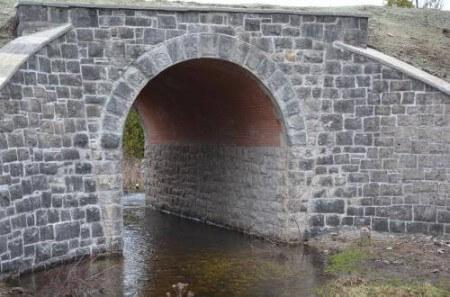
Fig2: Arch Culvert
Courtesy: civiltoday.com
Arch culverts are used in civil engineering and transportation infrastructure to allow water to pass under a road, train, or other artificial feature. It safely and efficiently transports water while supporting the roadway or embankment. Arch culverts have an arch or semi-circular shape. This design allows the culvert to uniformly distribute the overlying load throughout the sides and crown of the arch, reducing the requirement for support structures. The arch design also resists water and soil pressure on the culvert.
Arch culverts are made of concrete, stone, brick, or metal. Durability, strength, and versatility make concrete popular. The predicted water flow, stream or drainage channel size, and traffic or railway requirements determine an arch culvert’s size and dimensions. Arch culverts can support higher water flows or broader highways. The design considers hydraulic capacity, sediment movement, and environmental issues to prevent flooding and damage.
3. Pipe Culvert:
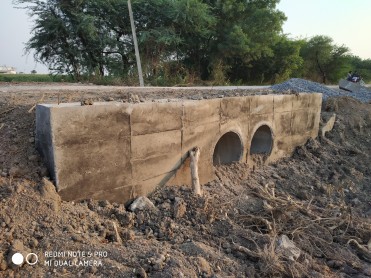
Fig3: Pipe Culvert
Courtesy: connectcivlengg.wordpress.com
A pipe culvert carries water, fluids, or other materials under roadways, trains, or other infrastructure. It’s a concrete, steel, or plastic pipe or set of pipes. A pipe culvert allows water or other fluids to flow from one side of a road or railway to the other. It prevents flooding, erosion, and infrastructure damage caused by water collection on the road surface—pipe culverts transport water, sewage, and electrical wires.
The project’s needs determine the pipe culvert’s size. The most prevalent shapes are circular, elliptical, and rectangular. Due to their structural economy and hydraulic performance, round pipes are commonly employed. High pressures and external loads don’t affect them. A trench or foundation is dug to install a pipe culvert. The pipes are positioned in the trench or foundation for effective flow. The pipe connections are sealed, and the area is backfilled to prevent leaks.
4. Bridge Culvert:
A bridge culvert combines the functions of a bridge and a culvert. It allows water to travel under a roadway or railway while providing a bridge for vehicles or pedestrians to cross the watercourse. Bridge culverts have a highway or railway deck supported by abutments or piers spanning the canal. The deck is usually made of reinforced concrete or steel girders for strength and load-bearing.
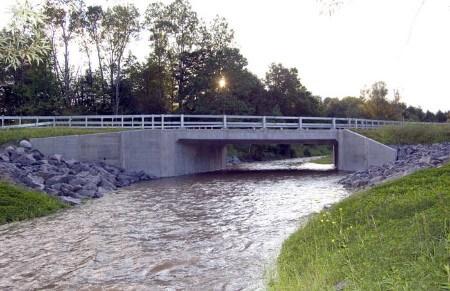
Fig4: Bridge culvert
Courtesy: binghamtonprecast.com
A bridge culvert keeps water flowing in a stream, river, or drainage canal. It prevents flooding and lets water flow freely under roads and railways. The culvert part is used to design the water flow rate, predicted flood levels, and watercourse size and shape. When a typical bridge isn’t practical or cost-effective, culverts are used. They are handy when the canal is small, or the road or railway crosses at an angle.
5. Metal Box Culvert:
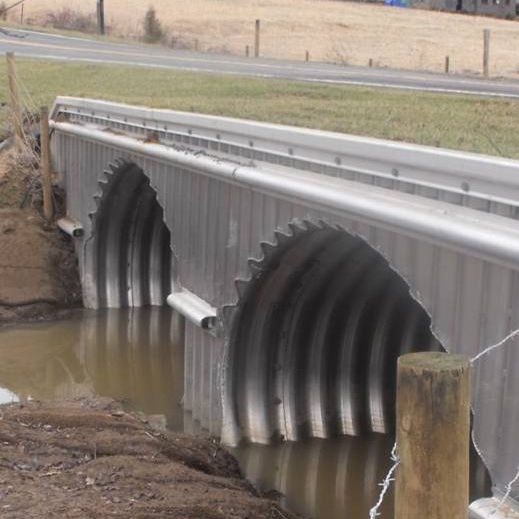
Fig5: Metal Box culvert
Courtesy: archiexpo.com
A metal box culvert is a structure used in civil engineering and construction to facilitate the passage of water or other fluids beneath roads, railroads, or other infrastructure. It consists of a rectangular or square-shaped box made of metal, typically steel or aluminum. The metal box culvert is designed to provide a strong and durable channel for water flow, allowing it to pass under a roadway or other obstacles. It is commonly used when open channels or bridges are not feasible or appropriate.
The culvert is usually constructed in sections or connected segments to form a continuous conduit. These segments are typically prefabricated off-site and then transported to the construction site for installation. The segments are designed to fit together tightly to create a watertight structure.
Advantages of Culvert:
Disadvantages of Culvert:
- During high rainfall or floods, culverts may overflow. It can cause upstream flooding.
- Debris, sediment, and vegetation can clog culverts. Water blockages cause localized flooding and infrastructural damage.
- Maintaining culverts is essential. Preventing blockages and deterioration requires clearing waste, sediment, and vegetation and restoring the damage.
- Erosion and scour near culverts can result from poor design or installation.
- Culverts can only carry a small amount of water or traffic.
Conclusion;
Culverts play a crucial role in managing water flow and ensuring the proper functioning of transportation systems, especially in areas with natural watercourses or drainage systems. Culverts are typically used to allow the passage of water under roads, railways, trails, or other structures, thereby preventing flooding, erosion, and damage to the infrastructure. They are designed to channel water from one side to another, maintaining the natural flow and preventing disruptions to the surrounding environment.
References:
1. Team, M. (n.d.). All You Need to Know About Culverts. All You Need to Know About Culverts. https://www.midasbridge.com/en/blog/all-you-need-to-know-about-culverts
2. P. (2020, November 16). Culvert [types, design aspects, failures] – Structural Guide. Structural Guide. https://www.structuralguide.com/culvert/
3. W. (2020, March 29). Construction Of Cross Drainage Structure | Box Culvert | Construction Civil. Construction Civil. https://www.constructioncivil.com/culvert-types-of-culvert-box-culvert/
4. What is a culvert? – LetsBuild. (2018, December 16). LetsBuild. https://www.letsbuild.com/blog/culvert
5. A. (2022, December 27). 7 Types of Culverts – Introduction, Material, Advantages & Disadvantages [Explained with Details]. Engineering Learn. https://engineeringlearn.com/types-of-culverts/
6. Gopinath, V. (2022, August 29). Types of Culverts – Culverts meaning and Culvert types Explained. Types of Culverts – Culverts Meaning and Culvert Types Explained | Vin Civilworld. https://vincivilworld.com/2022/08/29/culverts-meaning-types/
If you have a query, you can ask a question here.



Thank you for providing such a comprehensive and informative article about culverts. The detailed explanation of what culverts are, their types, materials, design considerations, and advantages/disadvantages really helped me understand their crucial role in managing water flow and maintaining transportation infrastructure. This article is a valuable resource for anyone looking to gain a deeper understanding of this essential component of civil engineering and infrastructure development. Great job!